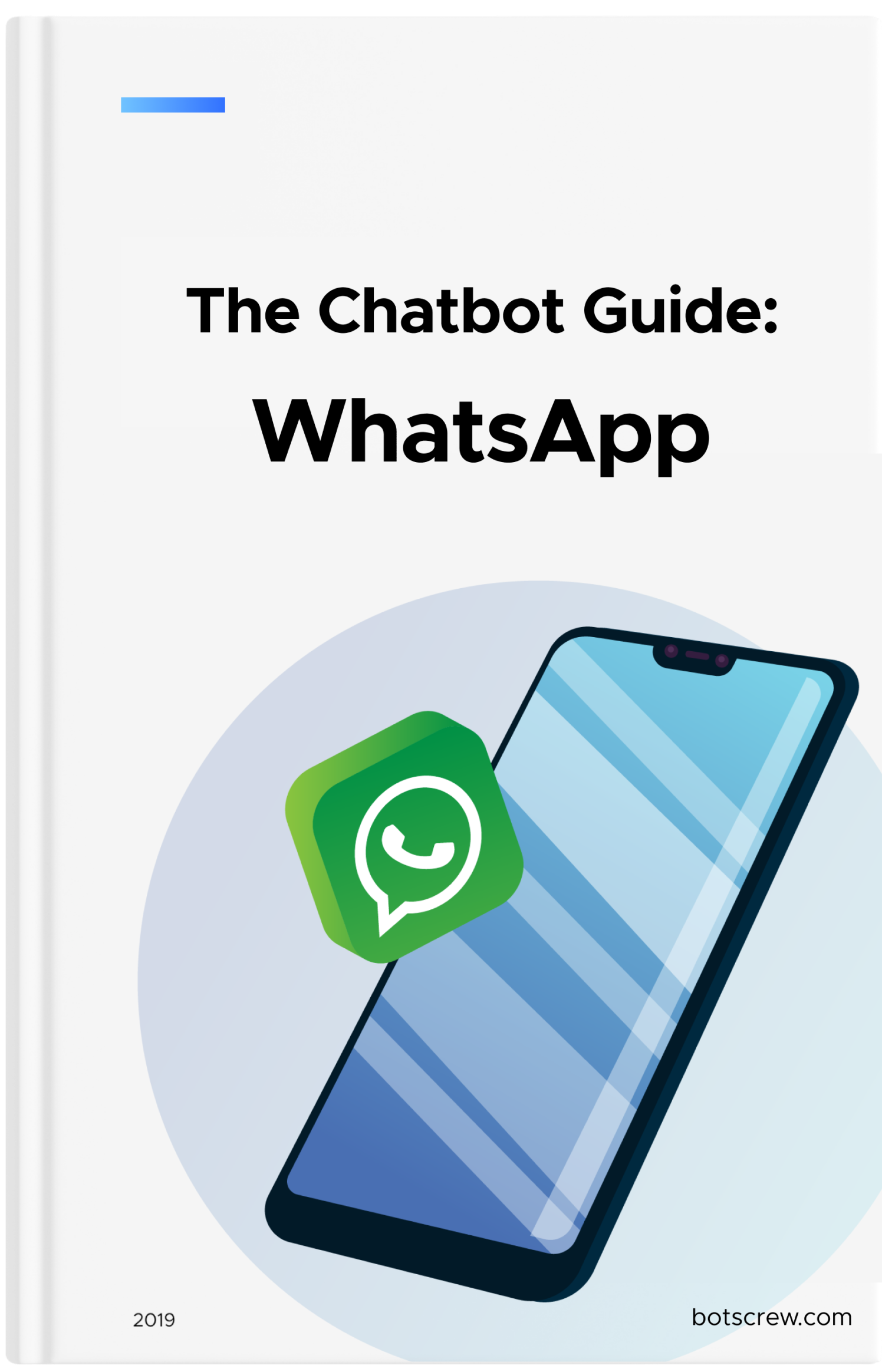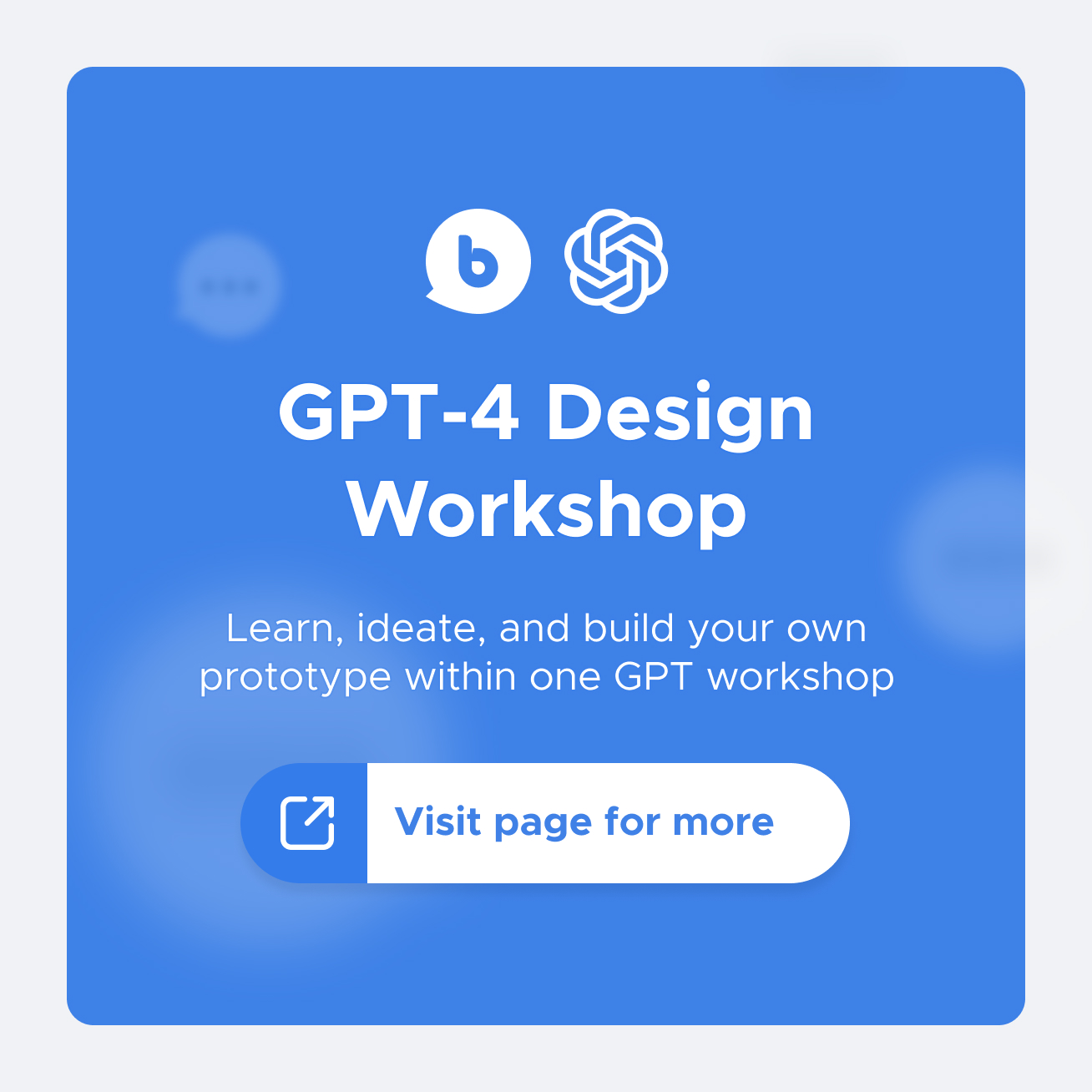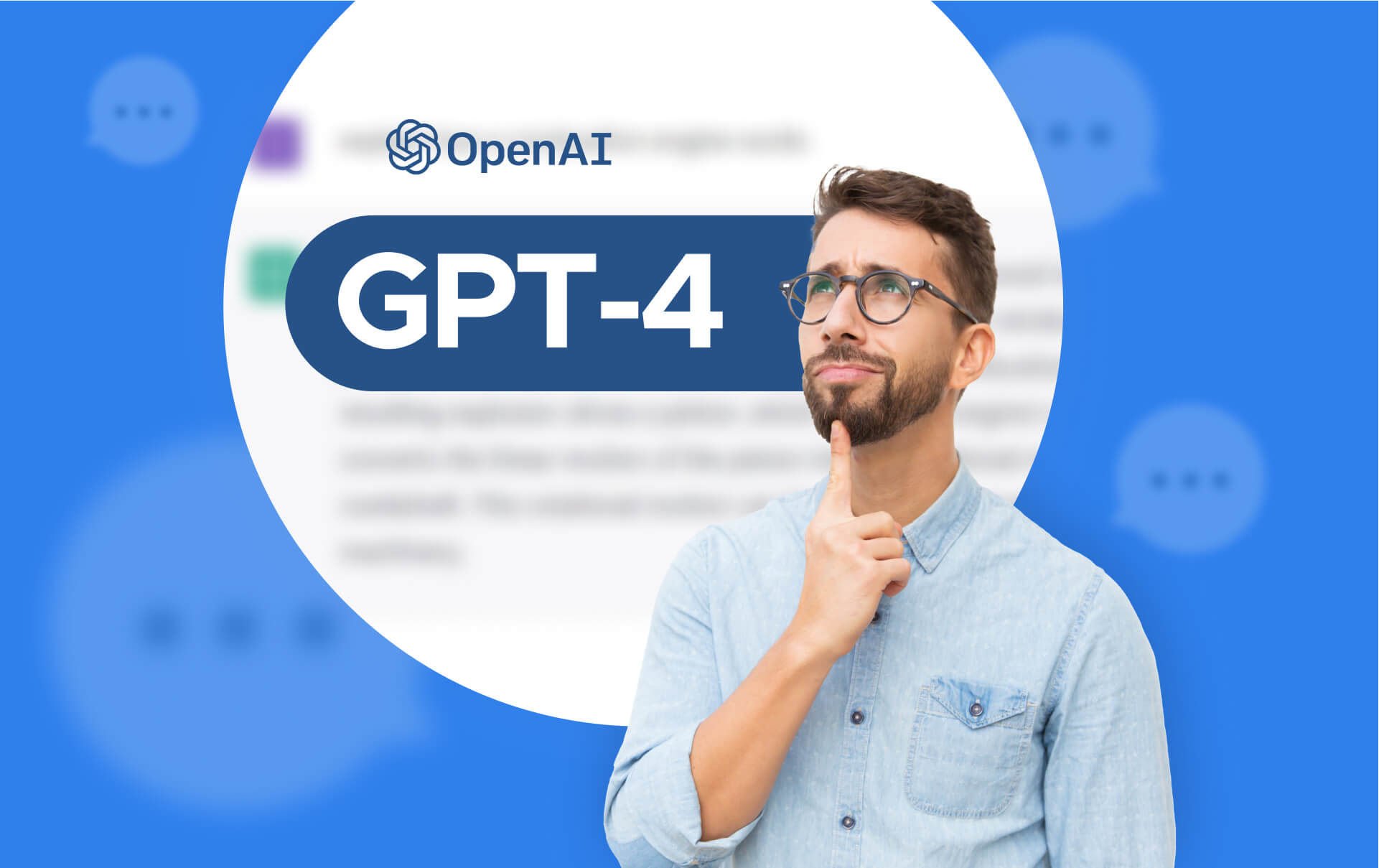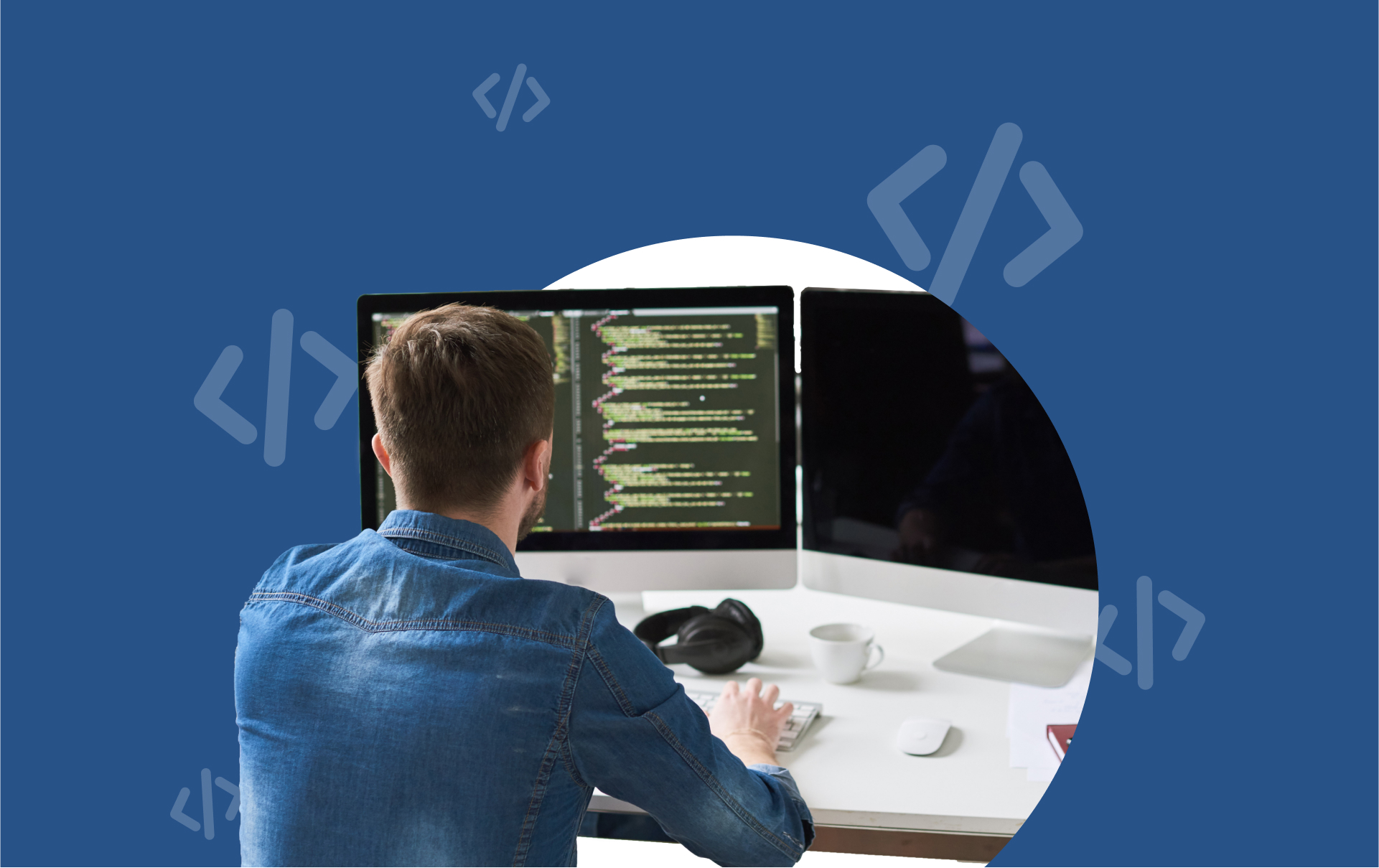How Do Chatbots Work? The Basics of Conversational AI
How do chatbots work? What is NLP? And what are the different types of chatbots? Get answers to your questions in this in-depth article.
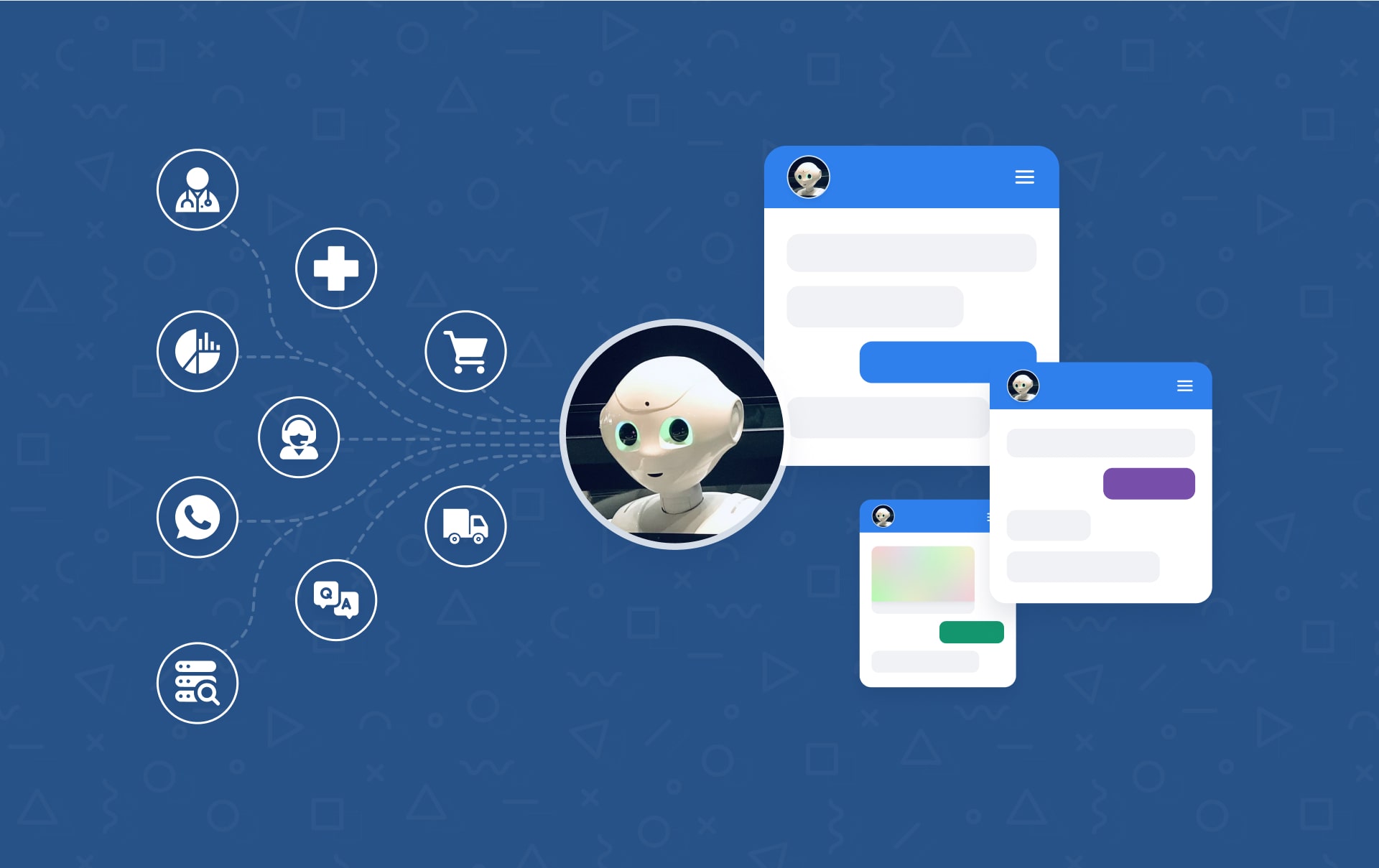
What is a chatbot?
A chatbot is a computer program or artificial intelligence (AI) that is designed to simulate human conversation and interact with users through text-based or voice-based interfaces. It is often used to provide information, answer questions, assist with tasks, or engage in conversation for various purposes.
Chatbots interpret and process users’ words or phrases and give an instant pre-set answer. They inhabit platforms like – FB Messenger, Whatsapp, Skype, Slack, Line, Kik, Wechat, or even your website. Similar to regular apps chatbots have an application layer, a database, APIs, and Conversational User Interface (CUI).(Make a chatbot that keeps the user in mind: these six unspoken rules will help you to avoid common mistakes that other companies have experienced and build a helpful, engaging, and easy-to-follow chatbot experience for users. )
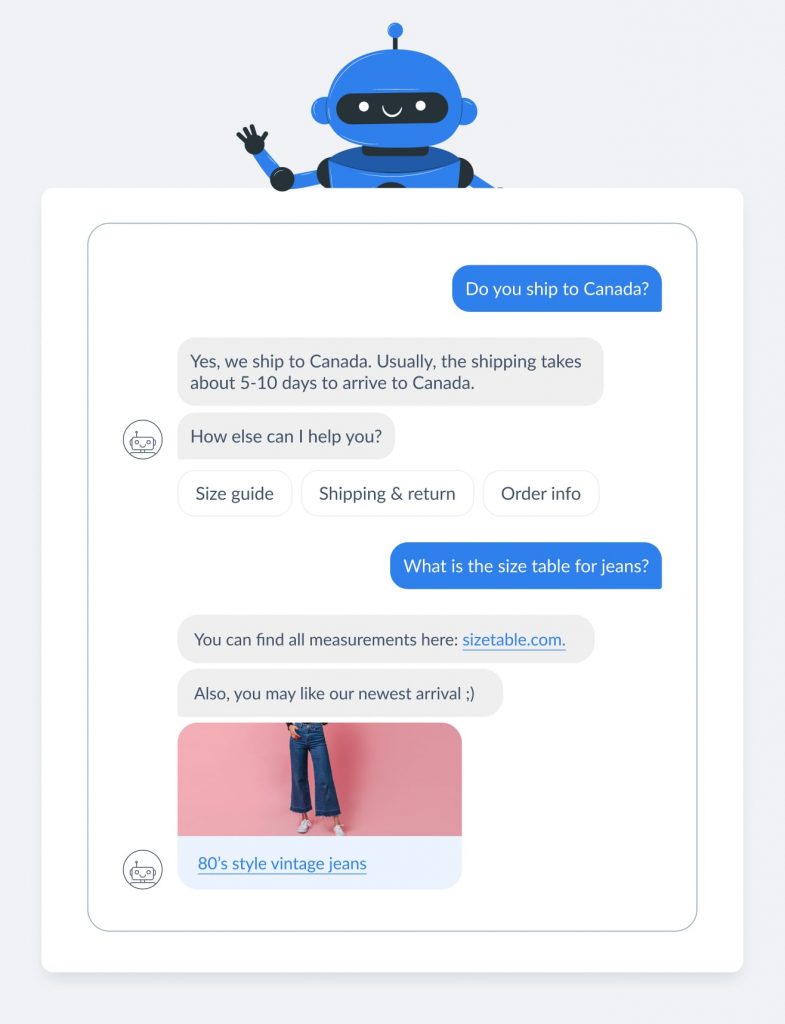
Natural Language Processing (NLP)
Before we jump into the part where we discuss how the chatbot works, let’s look at NLP.
What is NLP?
NLP stands for Natural Language Processing. It is a subfield of artificial intelligence (AI) that focuses on interactions between computers and human language. NLP involves studying and developing algorithms and techniques that enable computers to understand, interpret, and generate natural language meaningfully and usefully.
NLP involves 2 processes: Natural Language Understanding (NLU) and Natural Language Generation (NLG).
NLU is the ability of the chatbot to understand a human. It is the process of converting text into structured data for a machine to understand.
NLG transforms structured data into text.
Imagine a user writes to a chatbot, “What is the weather in San Francisco today?”. What is the chatbot doing? To give a reply chatbot breaks down the sentence into Intents and Entities.
An intent is an action or a request the user wants to perform or information he wants to get.
An entity is a detail that compliments the Intent. It can be a location, date, color, size, flavor, etc.
So, using the same example, the Intent here would be “Weather”. The entities would be “San Francisco" and “today".
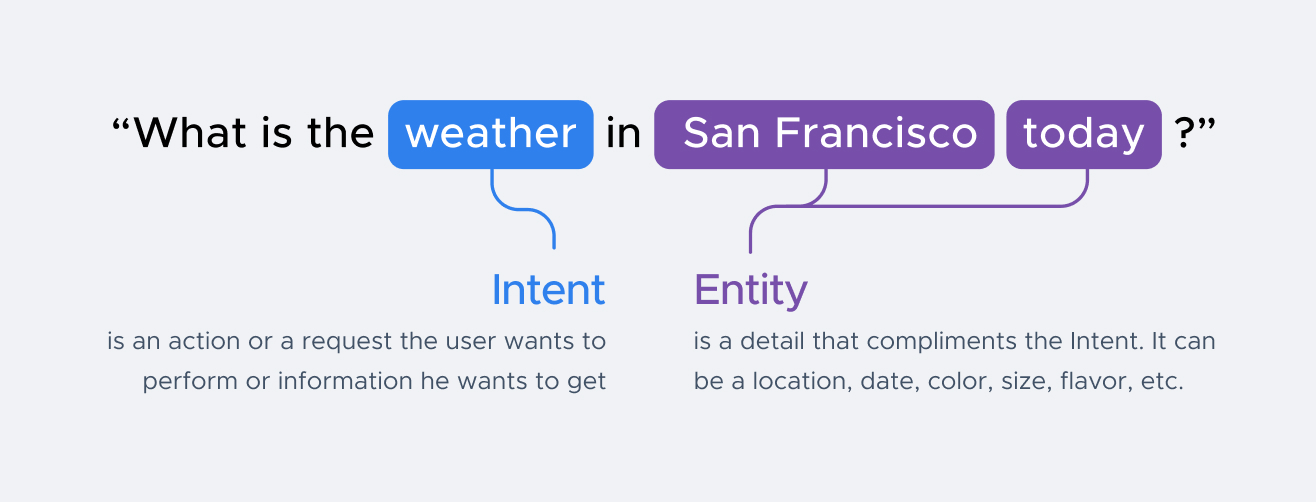
Here are some key components and tasks in NLP:
Tokenization: Tokenization is the process of breaking down a text into smaller units, typically words or tokens. It helps in preparing the text for further analysis and processing.
Part-of-Speech Tagging: This involves assigning grammatical tags to each token in a text, such as a noun, verb, adjective, etc. It helps in understanding the syntactic structure and meaning of the text.
Named Entity Recognition (NER): NER is the task of identifying and classifying named entities, such as names of people, organizations, locations, dates, and more, within a text. It helps in extracting important information and understanding the context.
Sentiment Analysis: Sentiment analysis, also known as opinion mining, aims to determine the sentiment or subjective information expressed in a piece of text. It can classify text as positive, negative, or neutral, providing insights into a document's overall sentiment or user feedback.
Text Classification: Text classification involves categorizing or labeling texts into predefined categories or classes. It is commonly used for tasks like sentiment analysis, topic classification, spam detection, and more.
How do chatbots work?
Chatbots work by combining several components and techniques to enable communication with users. The exact workings can vary depending on the specific implementation, but here's a general overview of how a chatbot typically works:
Input Processing: When a user sends a message to a chatbot, the input is received and processed. The chatbot uses NLP techniques to understand and interpret the user's message.
Intent Recognition: Once the input is processed, the chatbot tries to determine the user's intent or the purpose behind their message. It analyzes the context, keywords, and patterns in the user's query to identify the intended action or information sought by the user.
Dialogue Management: Dialogue management is responsible for keeping track of the conversation flow and determining the appropriate response based on the user's intent. It uses predefined rules or machine learning algorithms to select the appropriate response strategy. Rule-based approaches use if-then rules to match intents with corresponding responses, while machine learning-based approaches learn from a training dataset to generate responses.
Information Retrieval: If the chatbot needs to provide specific information to the user, it may need to retrieve it from a knowledge base or external sources. This could involve querying a database, searching a website, or accessing an API to gather the relevant information to include in the response.
Response Generation: Once the chatbot has determined the appropriate response based on the user's intent and any necessary information retrieval, it generates a response. This could involve generating text using predefined templates, selecting a preexisting response from a database, or using natural language generation techniques to create a response from scratch.
Output Formatting: Before sending the response back to the user, the chatbot may format it to ensure it is presented in a clear and user-friendly manner. This could include adding appropriate greetings, formatting the text, or including additional information or suggestions.
It's important to note that the complexity and capabilities of a chatbot can vary greatly depending on its design, underlying technologies, and the amount of training and data it has received. Some chatbots may be simple and rule-based, while others may be more sophisticated and employ advanced machine-learning algorithms for improved understanding and response generation.
What are the different types of chatbots?
- Rule-based chatbots
- AI-powered chatbots
- Generative chatbots
- Hybrid chatbots
- Voice chatbots
Rule-based chatbots
Rule-based chatbots operate based on a predefined set of rules and patterns. They follow a strict set of if-then statements or decision trees to determine the appropriate response to a user's input.
One advantage of rule-based chatbots is their simplicity and explicit control over the conversation. Developers have full control over the rules and can ensure the chatbot responds appropriately to specific inputs. However, they can be limited in handling complex or unexpected user inputs, as the chatbot's responses are based on predetermined patterns.
Rule-based chatbots are suitable for use cases where the conversation flow is well-defined and a limited number of possible user intents exist. They can be a good starting point for building basic chatbot functionality like FAQ chatbot. However, for more advanced and dynamic conversational experiences, other approaches like machine learning-based chatbots may be more suitable.
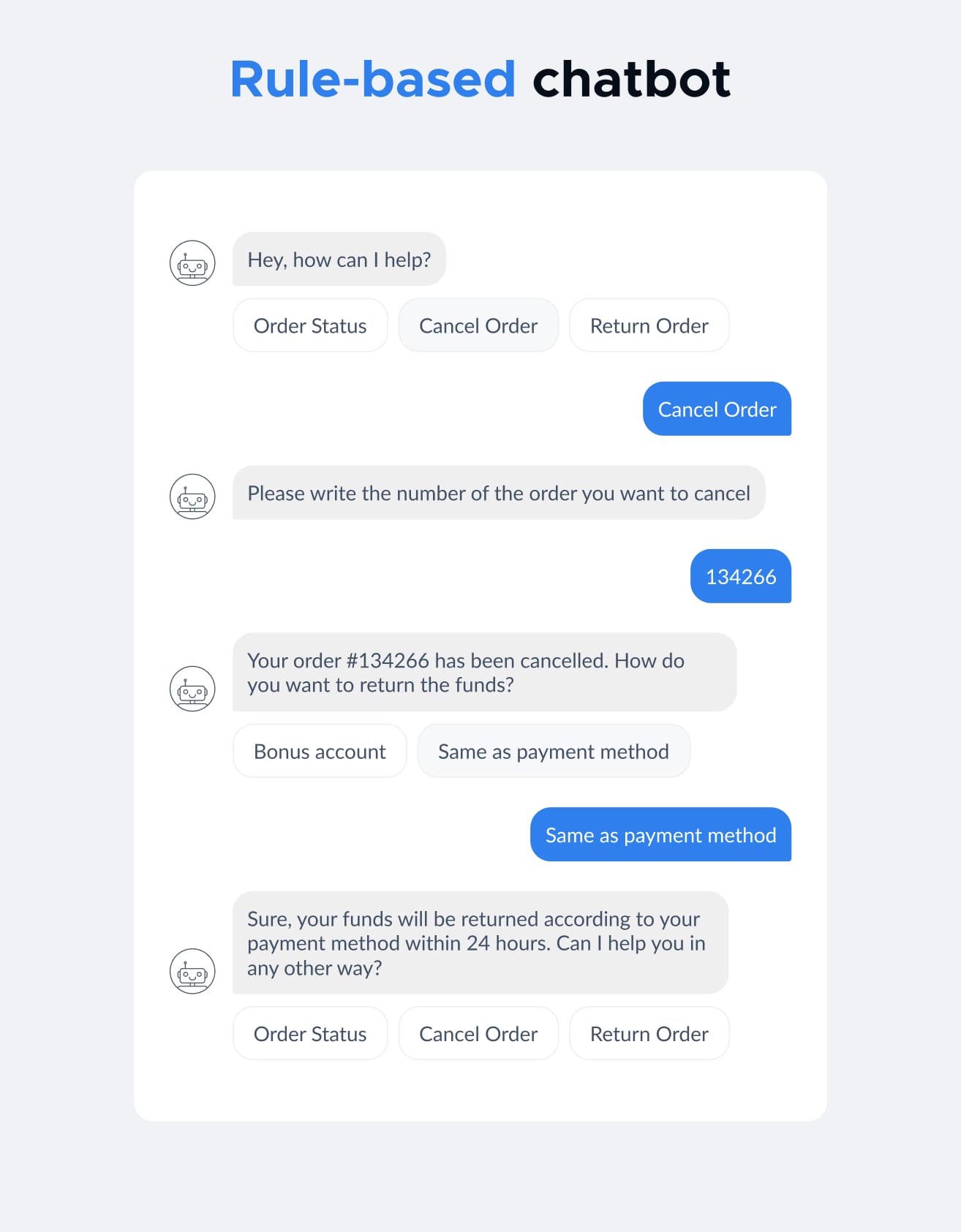
AI-powered chatbots
AI-powered chatbots, also known as AI chatbots, leverage artificial intelligence (AI) techniques and technologies, learned through the Artificial Intelligence course, to enhance their conversational capabilities. These chatbots utilize natural language processing (NLP), machine learning, and other AI algorithms to understand and respond to user inputs more intelligently and human-likely.
AI-powered chatbots offer more sophisticated and intelligent conversational experiences compared to rule-based or scripted chatbots. They can understand natural language, handle ambiguity, and provide contextually relevant responses. The use of AI technologies allows these chatbots to learn, improve, and adapt to user needs, resulting in more effective and human-like interactions.
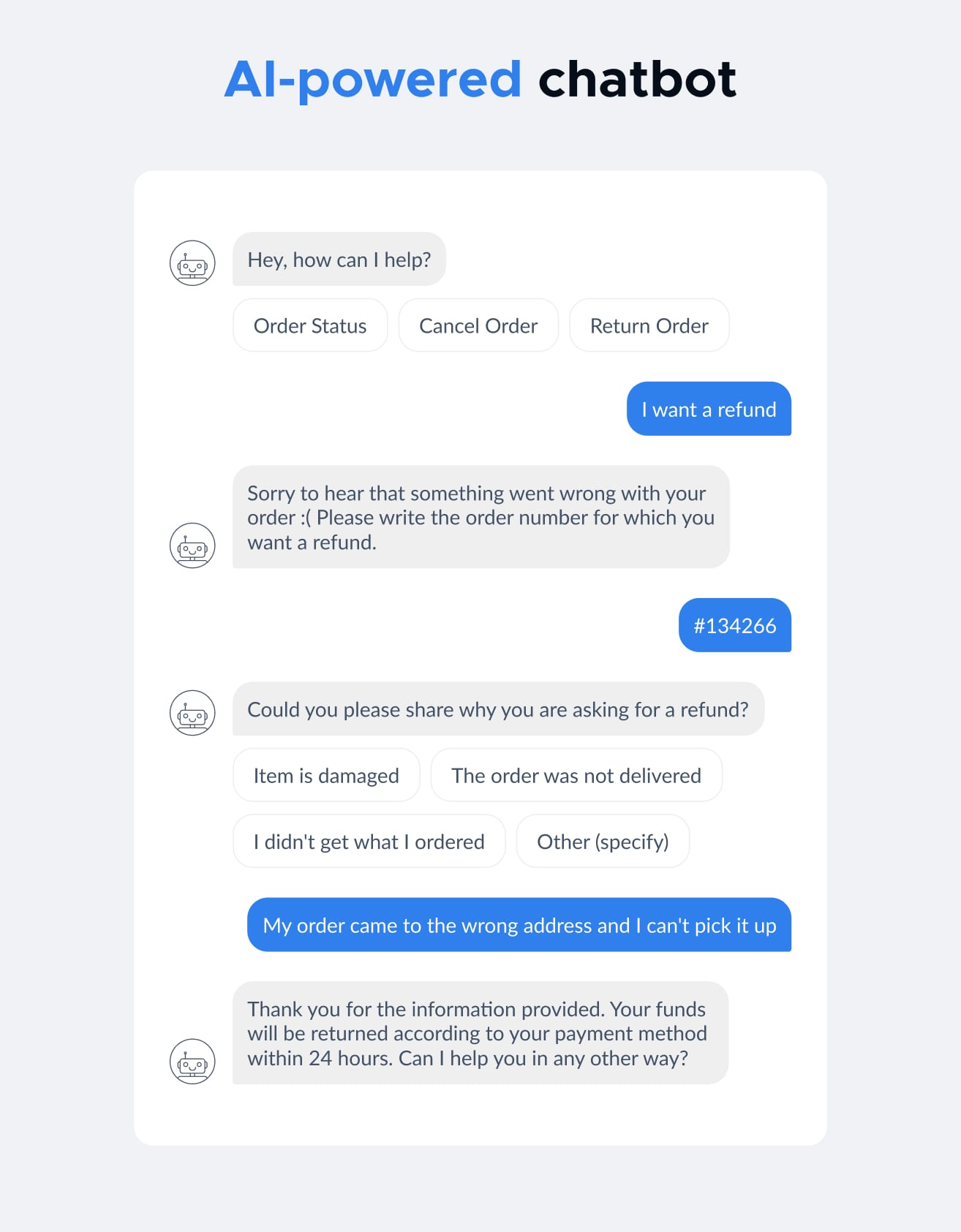
Generative AI Chatbots
Generative chatbots, also known as language models or conversational AI models, are chatbots that generate responses to user inputs dynamically rather than relying on pre-defined responses or templates. They use advanced machine learning algorithms, such as deep learning and neural networks, to generate human-like language and engage in natural conversations. These models are trained on large datasets of conversational data and can generate more diverse and contextually appropriate responses. Generative chatbots can be trained using supervised learning or reinforcement learning methods.
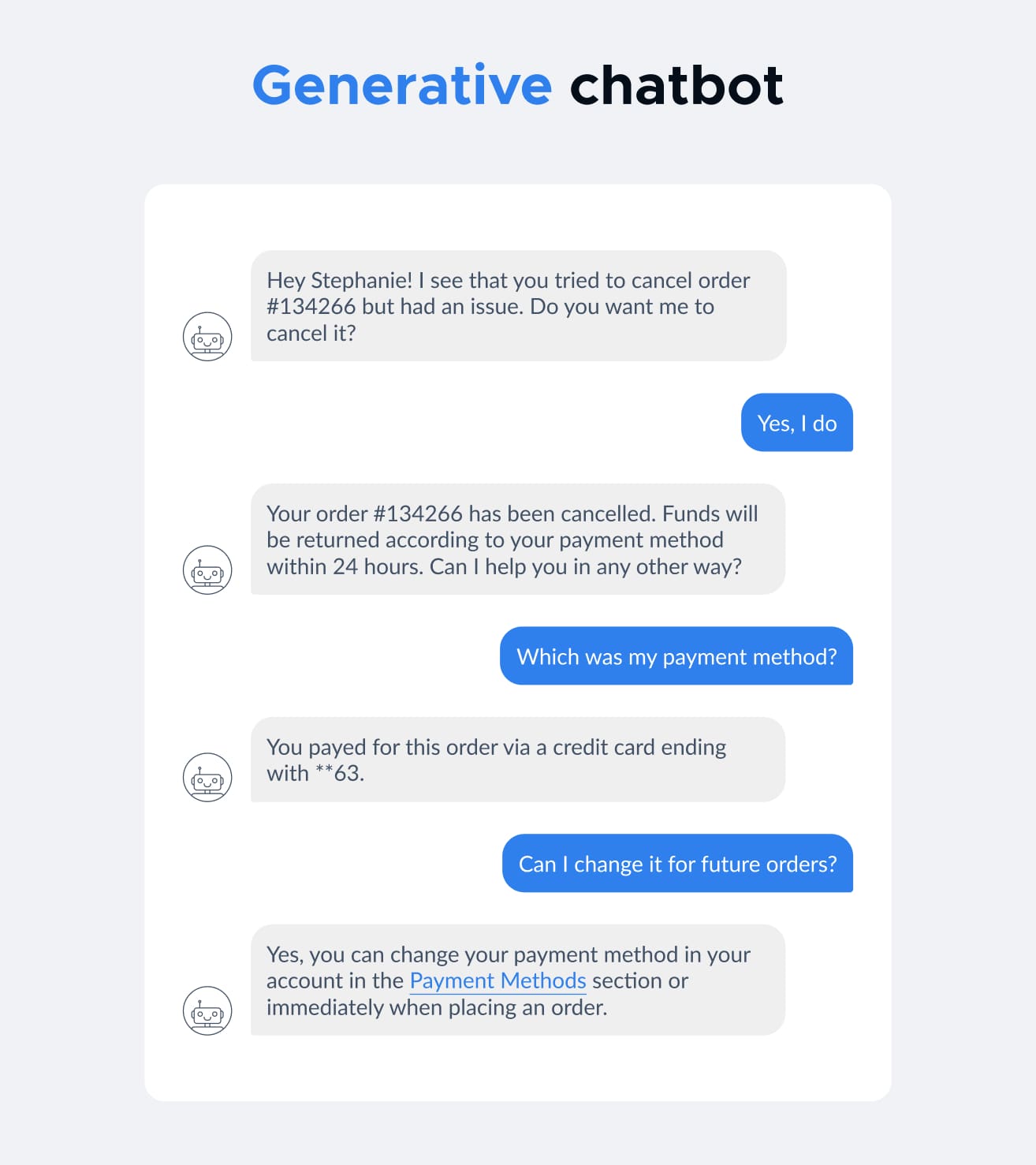
Generative chatbots are often powered by models like GPT (Generative Pre-trained Transformer). GPT is a specific type of generative model that has gained significant attention in the field of natural language processing (NLP) and conversational AI.
GPT is a transformer-based neural network architecture that utilizes deep learning techniques to generate human-like text. It has been trained on vast amounts of text data from the internet, allowing it to learn patterns, context, and language structure.
OpenAI, the organization behind GPT, has released several model versions, such as GPT-2, GPT-3, GPT-3.5, and GPT-4. These models have demonstrated impressive language generation capabilities and have been widely adopted for various NLP tasks, including chatbot development.
Generative chatbots powered by GPT models can produce contextually relevant and coherent responses based on the input they receive. These models can generate human-like conversations, understand the context of the conversation, and provide detailed and contextually appropriate answers.
Generative chatbots are often used in applications where engaging and interactive conversations are required. They are capable of handling open-ended questions, providing detailed explanations, and engaging in extended dialogues. However, due to their nature of dynamically generating responses, they may occasionally produce incorrect or nonsensical answers, which is a challenge that researchers and developers continue to address.
Hybrid chatbots
Hybrid chatbots combine multiple approaches or techniques to provide a more versatile and robust conversational experience. They integrate elements from different types of chatbots, such as rule-based, retrieval-based, and generative, to leverage each approach's strengths.
By combining different approaches, hybrid chatbots can provide a better user experience by leveraging the strengths of each technique. They offer more flexibility, accuracy, and natural language understanding than chatbots relying solely on one approach. Hybrid chatbots are particularly useful in handling complex and varied user interactions, as they can adapt to different scenarios and continuously improve their performance.
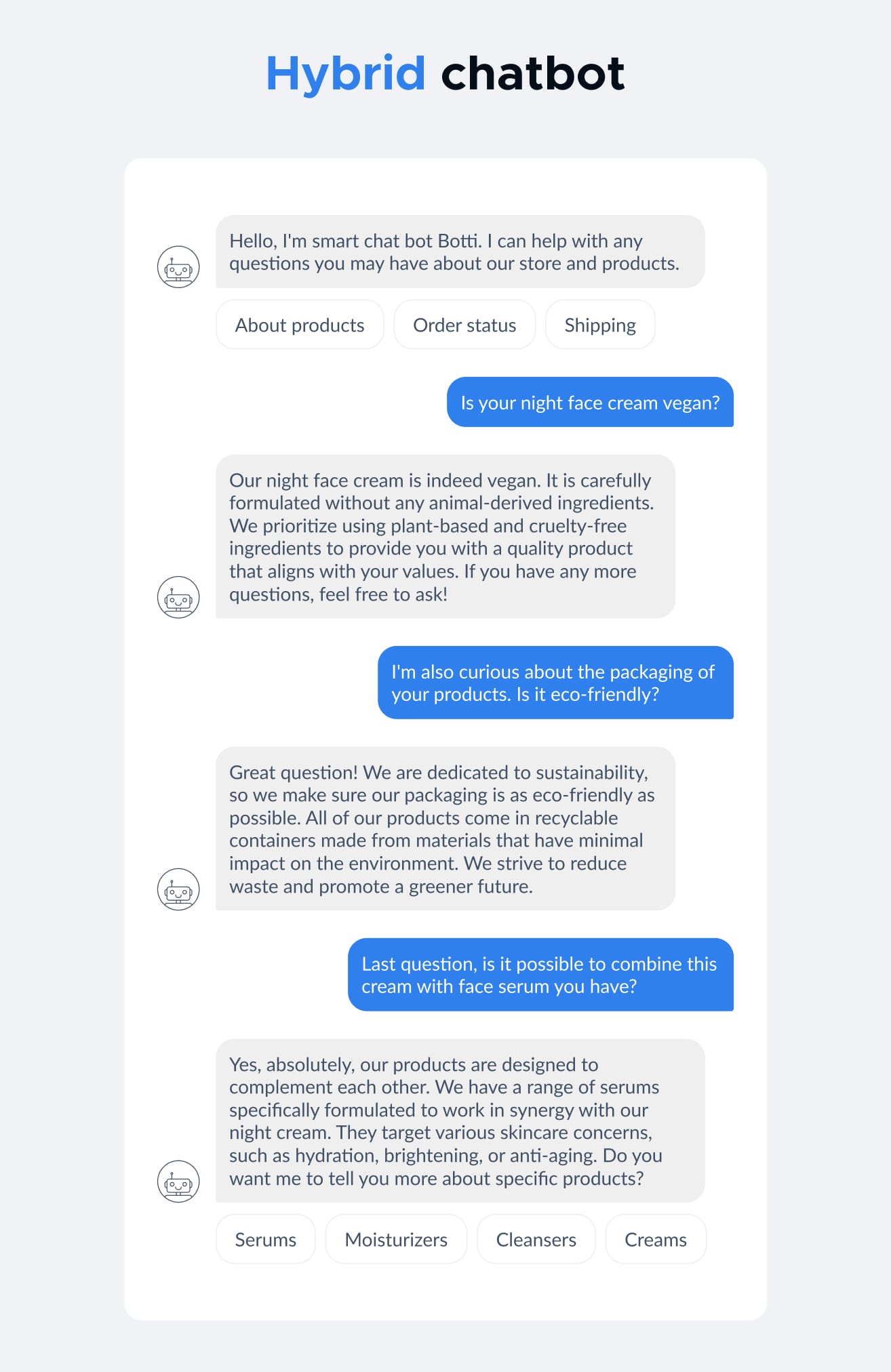
Voice chatbots
Voice chatbots, also known as voice assistants or voice-enabled chatbots, are chatbots that interact with users through spoken language instead of text-based input. They utilize speech recognition technology to convert spoken language into text and then process and generate responses using natural language understanding and generation techniques.
Voice chatbots are commonly found in devices such as smart speakers, smartphones, and other voice-enabled devices. They enable users to interact with technology through spoken language, making getting information, performing tasks, and receiving assistance easier and more natural.
What is chatbot architecture?
Chatbot architecture refers to the design and structure of a chatbot system. It outlines how different components of the chatbot interact with each other to enable its functionality. Although specific architectures can vary depending on the implementation and requirements, here are the key components commonly found in chatbot architecture.
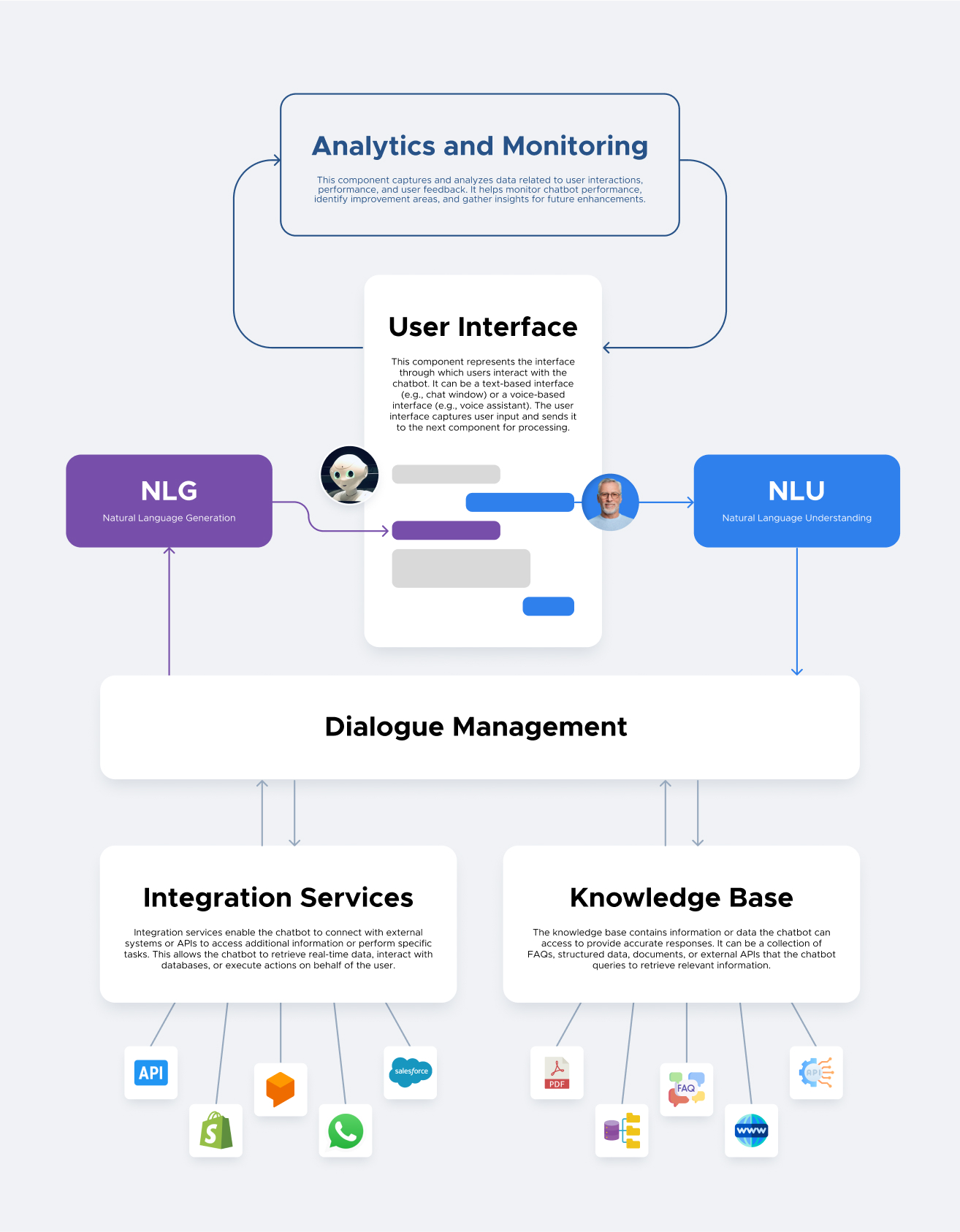
These components work together to enable the chatbot to understand user input, provide appropriate responses, and engage in meaningful conversations. The architecture may vary based on the complexity and specific requirements of the chatbot system.
What are some of the advantages of chatbots for business?
Chatbots are helpful in various ways and can provide numerous benefits in different contexts. Here are some of the key advantages and use cases of chatbots:
24/7 Availability: Chatbots can operate round the clock, providing instant responses and support to users anytime. This ensures users can access information and assistance outside regular business hours, enhancing customer satisfaction and convenience.
Customer Support and Service: Customer service chatbots can handle customer inquiries, provide support, and answer frequently asked questions. They can assist with tasks such as order tracking, troubleshooting, product recommendations, and general information, relieving the burden on customer support teams and reducing response times.
Download a full case study on how GSM Server automated customer support
Scalability: Chatbots can handle multiple conversations simultaneously, making them highly scalable. They can efficiently manage a high volume of inquiries without experiencing delays or overwhelming customer service representatives.
Cost Savings: By automating customer support and service tasks, chatbots can help organizations save costs. They can handle routine and repetitive inquiries, reducing the need for human resources and enabling businesses to allocate their personnel to more complex or specialized tasks.
Interested in real-world example of cost-saving chatbot? Read our case study: Leading cosmetics creator saved 20,919$ in 30 days
Personalized Interactions: Advanced chatbots can use data analytics and user profiles to offer personalized experiences. They can tailor recommendations, provide targeted information, and remember user preferences, creating more engaging and relevant interactions.
Lead Generation and Sales: Chatbots can act as virtual sales assistants, guiding users through purchasing, providing product information, and recommending suitable options. E-commerce chatbots can capture leads, collect user data, and initiate transactions, boosting sales and conversion rates.
Efficiency and Automation: Chatbots can automate various tasks and processes, saving time and effort for both businesses and users. They can handle forms, bookings, appointment scheduling, and other administrative functions, streamlining workflows and enhancing efficiency.
Engagement and Brand Experience: Well-designed chatbots can create interactive and engaging user experiences. They can employ conversational interfaces, multimedia content, and interactive elements to enhance brand engagement, build customer loyalty, and improve overall user experience.
FAQs
What is the difference between conversational AI and chatbot?
Conversational AI and chatbots are related concepts but have some differences in their scope and capabilities. Chatbot - A computer program that can talk with you and answer questions based on pre-set responses. Conversational AI - Technology that makes computers understand and respond to human conversation smartly and naturally. It's like teaching a computer to have a real conversation with you. Chatbots are one type of conversational AI, but conversational AI can do much more than just chat. It can understand and respond to spoken language, learn from interactions, and provide personalized assistance.
How long does it take to develop a chatbot?
The chatbot development timeline can range from a few weeks to several months. Simple chatbots with basic functionalities can be developed relatively quickly, while more complex chatbots with advanced AI capabilities and extensive integrations may require more time. It's crucial to carefully plan and assess the chatbot’s requirements to estimate a realistic timeline for development.
What are some of the chatbots’ best practices?
One of the main chatbot's best practices is - defining a clear purpose and scope for your chatbot. Identifying specific goals and use cases it will address to ensure it provides value to users. Also, designing the chatbot with the user in mind. Make it intuitive, easy to use, and provide clear instructions. Consider user preferences, context, and language to create a positive user experience. Lastly, regularly updating and enhancing the chatbot's knowledge base, incorporating user feedback, and staying up-to-date with advancements in NLP and conversational AI technologies to continually improve the chatbot's effectiveness.




